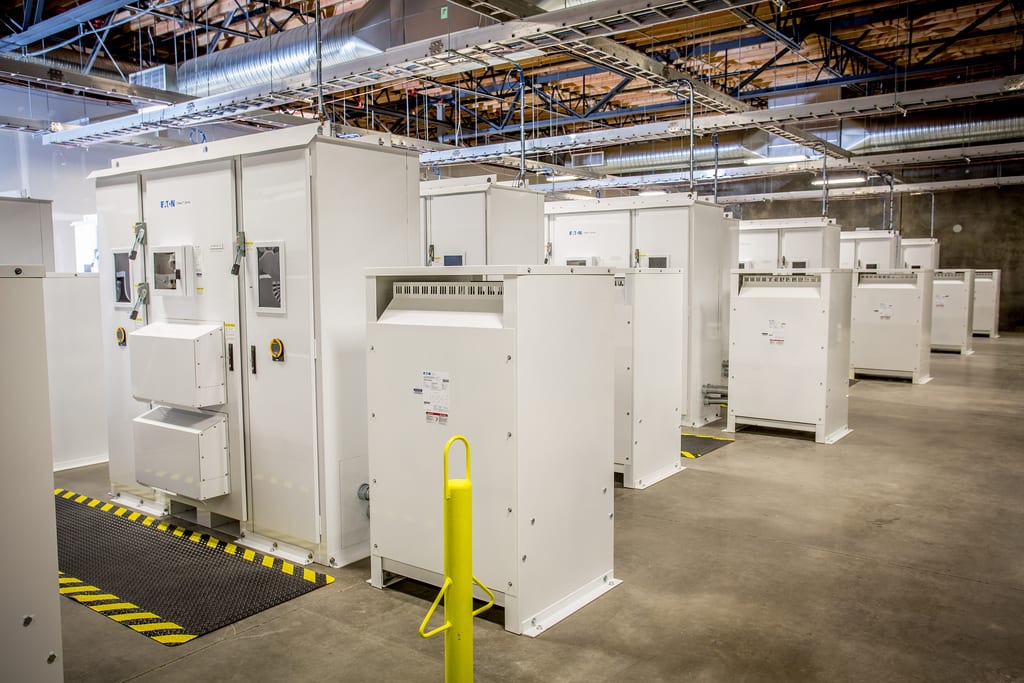How It Works: Inverters
What Is An Inverter?
A power inverter is a device that converts DC (direct current) to AC (alternating current).

Image obtained with thanks from portland general on Flickr.
This conversion is often needed to:
- Convert the DC current from batteries to 110 volts or 240 volts AC to power plug-in household appliances such as standing fans, air conditioners, etc. These power inverters are especially used to convert DC solar power to AC to power entire buildings.
- Convert the DC current from solar power systems to high-voltage AC for transmission through the electricity grid.
- Convert low-voltage DC current from laptop batteries to high voltage AC to power their fluorescent backlights.
- Convert DC current from electric car batteries into variable-frequency AC to power their electric motors.
- Convert 60 Hz AC current to DC, so it can then be alternated at a variable frequency for inverter air conditioner compressors (the temperature of an inverter air conditioning system is controlled by varying the frequency of the compressor motor to increase or decrease its speed based on cooling demand).
How Inverters Work
Electronic power inverters use an oscillating electronic circuit, which comprises a combination of transistors, capacitors, and other parts to reverse the DC current at 50-60 times per second (which is 50-60 Hz, 60 Hz in the U.S.). At this point, the current has been converted to AC. That means the built-in step-up transformer is now capable of increasing the voltage from 12 volts DC to the 110-240 volts AC that all of your plug-in appliances require, or for any of the other applications mentioned in the list above.
There are also mechanical inverters. However, electronic (semiconductor) inverters are the most common (they are the standard now).
Alternative Step-By-Step Explanation
Step One: The current is reversed (alternated) by the electronic circuit mentioned above.
Result: The current is now 12 volts AC at 50 or 60 Hz.
Step 2: The transformer multiplies that AC current by a factor of 10 (or 20) to 120 volts AC (or 240 volts in Europe).
Result: The current is now suitable for plug-in appliances.
Inverter Troubleshooting
Issue: The inverter beeps and/or shuts off.
Possible Reasons:
The appliance plugged into the inverter requires more power than the battery can provide, this causes the battery voltage to drop, signalling the inverter to shut off. This may also mean that the appliance exceeds the inverter’s capacity. Solution: Buy a larger battery, or buy a larger inverter.
12 Volt battery sizing guide:
Multiply the battery’s capacity (measured in Ah, which means amp-hours) by 12 to get its capacity in Wh (watt-hours). Then, ensure that the device you will power it with is equal to or less than the Wh figure you got. If its power consumption is equal to the Wh rating, the battery will likely power it for about 40 minutes before the inverter trips out.
This applies to conventional lead-acid batteries. However, the same can be applied to lithium-ion batteries.
Ensure that the battery is charged and in good health: Once charged. Let the battery sit disconnected for at least two hours, then check the voltage. If your multimeter or voltmeter reads 12.75 volts to 12.9 volts, it is fully charged, and able to retain its charge.
How To Get 220 Volt To 240 Volt Inverters
Order them from the U.K. or elsewhere in Europe! 220 volt inverters are harder to find in countries where 120 volts is the standard. They are abundant in U.K. stores (or stores optimized for the U.K.) such as Amazon.co.uk.




